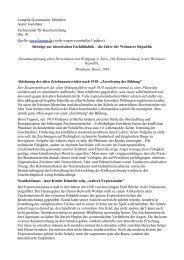Research in Visual Arts Education - The National Society for ...
Research in Visual Arts Education - The National Society for ...
Research in Visual Arts Education - The National Society for ...
You also want an ePaper? Increase the reach of your titles
YUMPU automatically turns print PDFs into web optimized ePapers that Google loves.
MULTICULTURALISM AND ARTS-BASED RESEARCH<br />
discourse analysis to study different conceptions of art education, especially<br />
the DBAE-movement. In her dissertation (2004), she focuses on how multiculturalism<br />
is approached <strong>in</strong> different fields of arts education. Riitta Apuli-<br />
Suuronen (1999) uses discourse analytical tools when compar<strong>in</strong>g written<br />
documents of F<strong>in</strong>nish and Swedish upper secondary school art curricula <strong>in</strong><br />
her research, which is the only study <strong>in</strong> F<strong>in</strong>land related to the category of<br />
arts education policy. Discourse analysis is also used <strong>in</strong> Pirkko Pohjakallio’s<br />
(2005) dissertation of the chang<strong>in</strong>g justifications <strong>for</strong> art education between<br />
1945 and 1990. Her study is based on biographical <strong>in</strong>terviews and it is a part<br />
of a larger research project on the history of F<strong>in</strong>nish art education. Another<br />
work related to this field is Kerttu Mäkelä’s (2002) licentiate thesis about the<br />
F<strong>in</strong>nish folk-school teacher tra<strong>in</strong><strong>in</strong>g sem<strong>in</strong>ars <strong>in</strong> the years 1899–1945.<br />
Art appreciation is an example of an area where different research categories<br />
overlap. Because this concept has its connections to the field of aesthetics<br />
and museum education, art understand<strong>in</strong>g is a more proper word to<br />
describe the first dissertation study of the Department of Art <strong>Education</strong> at<br />
the UIAH. In her thesis, Marjo Räsänen (1997) builds bridges between different<br />
approaches to art education and develops a constructivist-experiential<br />
framework <strong>for</strong> picture analysis as a tool <strong>for</strong> identity construction. Her ma<strong>in</strong><br />
idea is to f<strong>in</strong>d connections between the cultures <strong>in</strong> and beyond the artwork<br />
by contextualiz<strong>in</strong>g its viewer and maker. Räsänen’s description of aesthetic<br />
development has connections to child study and her discussion about visual<br />
conceptualization refers to theories of learn<strong>in</strong>g and mean<strong>in</strong>g-mak<strong>in</strong>g. Similarly<br />
to Räsänen, Juha Merta (2006) emphasizes the role of productive activities<br />
as a tool <strong>for</strong> understand<strong>in</strong>g art and self while portray<strong>in</strong>g elementary teacher<br />
students. Parallel to the analysis of students’ art <strong>in</strong>terpretation follow<strong>in</strong>g<br />
Räsänen’s “model” of picture analysis, Merta describes his own processes of<br />
art mak<strong>in</strong>g. Picture analysis has obvious connections to art criticism and<br />
often also to discourse analysis.<br />
A more direct connection to art appreciation <strong>in</strong> its aesthetic mean<strong>in</strong>g<br />
is seen <strong>in</strong> Pirjo Viitanen’s (1998) research about the art preferences of elementary<br />
school students. Art appreciation is also the goal of Anna-Maija<br />
Issaka<strong>in</strong>en’s (2004) study of museum education, where she discusses <strong>in</strong><strong>for</strong>mation<br />
networks as a channel of mediat<strong>in</strong>g art and describes cooperation<br />
between one school and a museum. Another project aimed at connect<strong>in</strong>g<br />
schools and museums is described <strong>in</strong> the licentiate thesis of Marja-Leena<br />
Bilund and Sirpa Svahn-Kumpula<strong>in</strong>en (2005). A historical view to art<br />
museum education can be found <strong>in</strong> Tapio Suom<strong>in</strong>en’s (1998) licentiate thesis<br />
about Alfred Lichtwark.<br />
An important issue related to F<strong>in</strong>nish research <strong>in</strong> art education (as well<br />
as educational research <strong>in</strong> general) is the relationship between research and<br />
104 NORDIC VISUAL ARTS EDUCATION IN TRANSITION



